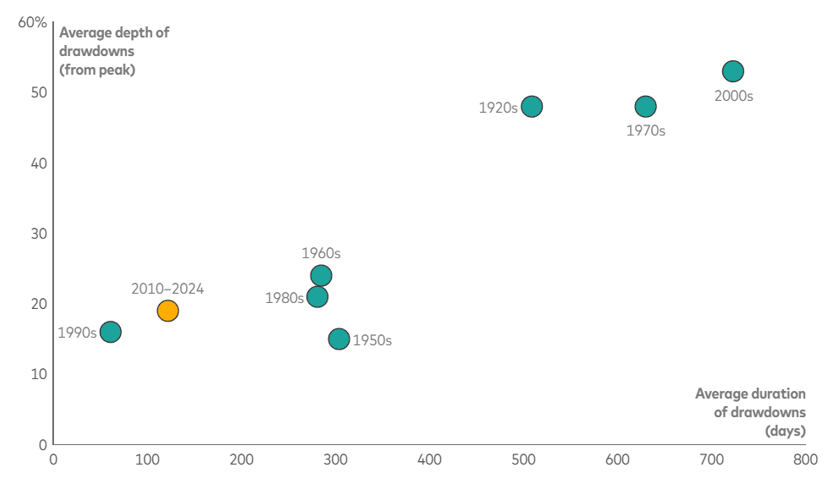As the winter chill lingers, we look forward to the arrival of spring and brighter days ahead.
Interest rates and tariffs continue to influence markets globally.
In Australia, soft inflation data has paved the way for a possible rate cut. CPI slowed more than expected to an annual rate of 2.1% from 2.4% and core inflation – the RBA’s preferred measure – fell to 2.7% from 2.9%.
US interest rates were kept steady in July despite pressure from President Trump. The greenback eased in response, providing a small boost to the Australian dollar, which has been on a rollercoaster ride in recent times
The US S&P 500 and Nasdaq 100 continue to record all-time highs as tariffs begin to be locked in and AI investment takes off.
Meanwhile, the S&P ASX 200 experienced another volatile month, but the trend continued upwards and included an all-time high.
There are also signs of consumer optimism. The July Westpac–Melbourne Institute Consumer Sentiment Index found consumers buoyed by the chance of interest rate cuts this year.
Market movements and review video – August 2025
Stay up to date with what’s happened in the Australian economy and markets over the past month.
Interest rates and tariffs continue to influence markets globally.
After the RBA’s surprise move to leave rates on hold at its July meeting, soft inflation data has paved the way for a future rate cut.
The ASX 200 climbed to a fresh record high during the month of July. Wall Street also recorded all-time highs as tariffs begin to be locked in and AI investment takes off.
Click the video below to view our update.
Please get in touch if you’d like assistance with your personal financial situation.
Planning is key as SMSFs enter new phase
Self-managed superannuation funds (SMSFs) have long been associated with older Australians and small business owners looking for greater control over their retirement savings.
But recent data suggests the sector is undergoing a quiet transformation.
Alongside tax reforms and persistent compliance challenges, younger people are slowly moving into the SMSF space. While 85 per cent of SMSF members are 45 years or older, there’s been significant growth in members aged between 25 and 34 years from just 2.4 per cent two years ago to around 10 per cent now.i
Almost 8,000 new SMSFs were established in the three months to the end of March 2025 with the number of new members increasing by 13,000. Australia’s SMSFs hold an estimated $1.02 trillion in assets with 26 per cent invested in listed shares and 16 per cent in cash and term deposits.ii
A new tax era
The new Division 296 super tax, due to apply from 1 July 2025, is aimed at those with total superannuation balances exceeding $3 million. An extra 15 per cent tax will apply to earnings on the portion of a member’s balance above $3 million, effectively lifting the tax rate on those earnings to 30 per cent.
What makes Division 296 particularly contentious is the inclusion of unrealised gains. For example, a share portfolio the SMSF holds has seen positive returns. Trustees may face tax liabilities on paper profits, even if assets haven’t been sold. This may cause issues for SMSFs holding illiquid assets such as property or farmland that has increased in value.
SMSF Australia and other industry bodies have raised concerns about fairness, complexity and the potential for unintended consequences.
Trustees with high balances should begin planning now before 30 June 2026, to consider asset rebalancing, contribution strategies and the timing of withdrawals. SMSF Australia recommends obtaining advice about your specific circumstances.iii
The advice gap
Despite the increasing complexity of SMSF regulation, the vast majority of trustees continue to operate without professional advice. While the number of SMSFs using financial advisers has grown to 155,000, up from 140,000 in 2023, some 483,000 are not using a financial adviser.iv
This could lead to costly mistakes, especially when navigating contribution caps, pension strategies or related-party transactions. SMSF Australia says that while there’s no legal requirement to obtain advice from a licensed financial planner, “unless you have the skills and expertise to do this yourself, it is certainly conventional wisdom to do so”.v
The compliance burden
Every SMSF must undergo an annual audit by an approved SMSF auditor. This includes verifying the fund’s financial statements and ensuring it is compliant with super laws. Trustees are also required to value all fund assets at market value as at 30 June each year, using objective and supportable data.
For property and other complex assets, valuations can be time-consuming and costly. The ATO recommends using qualified independent valuers when assets represent a significant portion of the fund or are difficult to assess. Auditors may request evidence such as comparable sales, agent appraisals or formal valuation reports.vi
Failure to maintain accurate records or provide sufficient documentation can result in audit delays, contraventions or penalties. Trustees must also ensure their investment strategy is regularly reviewed and documented, particularly when starting pensions or making significant contributions.
Looking ahead
As the SMSF sector evolves, trustees face a dual challenge: adapting to new tax rules and maintaining rigorous compliance. For those considering an SMSF – or already managing one – the message is clear. Getting financial advice can give you peace of mind when the rules are regularly changing.vii
With Division 296 to contend with and a younger demographic stepping in, the sector is poised for both growth and greater scrutiny.
Whether you’re a seasoned trustee or just starting out, now is the time to review your fund’s structure, seek expert guidance and ensure your paperwork is in order. The future of SMSFs may be more dynamic than ever, but it will also demand greater diligence.
Contact us if you have any questions.
i Highlights: SMSF quarterly statistical report March 2025 | Australian Taxation Office
ii Self Managed Superannuation Funds – SMSF quarterly statistical report March 2025 – Data.gov.au
iii Understanding Div296 I How will taxation of unrealised gains work
iv New SMSF trustees propel uptake of financial advice, but $1 trillion sector still has significant advice gaps | Vanguard Australia
v What are the rules for Financial Planners giving SMSF Advice? – SMSF Australia
vi SMSF administration and reporting | Australian Taxation Office
vii About SMSFs | Australian Taxation Office
Keeping your cool when the markets heat up
Investing isn’t just a numbers game. It’s an activity that stirs various emotions from hope and optimism to fear and anxiety.
Whether the ASX is surging or stumbling, emotional responses to market movements can shape outcomes just as much as economic fundamentals. Understanding those responses is crucial to building resilience, especially in unpredictable times.
These patterns underscore the importance of long-term perspective, especially in a market shaped by both global sentiment and uniquely local factors.
How emotions enter the equation
We like to think our financial decisions are rational, but the truth is more complex. Investors aren’t robots crunching numbers in isolation. We are influenced by news cycles, cultural values and personal stories from friends, family and colleagues.
When markets rise, euphoria and FOMO can drive hasty buying decisions. During downturns, anxiety and regret can push investors to sell at a loss, despite having sound long-term strategies.
This pattern has played out across decades, from the dot-com bubble to the COVID recovery. And remember that emotional investing isn’t just a beginner’s problem. Even seasoned investors can be swept up by sentiment if safeguards aren’t in place.
Psychologists have long observed how financial stress activates similar responses to physical threats, triggering fight-or-flight instincts rather than thoughtful analysis. That’s why even well-informed investors may react defensively when facing market instability.
The good, the bad and the balancing act
Emotional investing isn’t all risk. In the right conditions, it reflects conviction, clarity and purpose. For example, values like patience and belief in the future can help investors stay committed during market dips.
Life changes such as home ownership, welcoming a child or retirement can bring useful emotional clarity to financial decisions. And ethical investing often stems from emotions such as care and connection to community.
When used with discipline, emotions can reinforce sound decisions rather than undermine them. Investors who use emotional clarity to establish long-term goals tend to feel more confident, even when short-term volatility strikes.
That said, emotions can also derail strategy. Panic selling during downturns, overconfidence after gains and herd mentality all pose risks.
The 2022 market correction saw many Australians pull out of super investments prematurely, missing the rebound that followed. These reactions stem not just from fear but also from a desire to act, even when patience may be more effective.
Learning from behavioural finance
Behavioural finance gives us tools to interpret emotional reactions. Biases like loss aversion, recency bias and anchoring affect decision-making in subtle but powerful ways.
These include:
- Loss aversion – People often feel the sting of losses more intensely than the joy of equivalent gains, which can lead to overly cautious or reactive choices.
- Recency bias – Recent events weigh heavily on perceptions, leading investors to expect trends will continue simply because they’ve just occurred.
- Anchoring – Fixating on a past portfolio value or arbitrary benchmark can skew rational assessment.
Recognising these tendencies helps investors avoid knee-jerk decisions and design portfolios that stay aligned with goals over time. It’s not about eliminating emotion; it’s about becoming aware of how it operates and mitigating its effects through smart responses.
After all, markets are always shifting. Emotions will always emerge. The goal isn’t to shut them out, but to understand them and develop structures to keep emotions from steering the ship. When investors learn to pause, reflect and act with intent, they not only improve outcomes but feel more confident in their journey.
If you’d like to explore strategies to build emotional resilience in your portfolio, or tools to help remove bias from investment decisions, please give us a call.
Assessment and eligibility for aged care services
Key points:
- My Aged Care will be your first point of contact if you are in looking to access Government funded aged care services
- A RAS or ACAT/S assessment can determine what services will best suit your needs
- If you are found eligible for government-funded services, you will then be able to start looking for aged care providers
UPDATE — from December 9, 2024, the Single Assessment System replaced the Regional Assessment Service, independent Australian National Aged Care Classification assessors and ACAT/ACAS specialists. Every approved assessor will be able to deliver an assessment for each level of support, whether in-home or for residential care. More information can be found on the Aged Care Guide website.
The first thing you need to do is register with My Aged Care. This is the agency that looks after all government-funded aged care programs.
When you first call the My Aged Care Contact Centre, on 1800 200 422, an operator will register you and ask you a number of questions about your personal circumstances and care needs.
These questions will be quite basic and shouldn’t take too long. All you will need is your Medicare card when you call as this information is stored with your other details on the My Aged Care database.
Examples of the questions you will be asked are:
- Are you currently receiving aged care services?
- Are you getting support from a carer or family member?
- Can you prepare your own meals and do housework?
- Do you need assistance taking a shower or bath and do you need help getting dressed?
- Are there any health concerns or did you have a recent fall?
- Do you feel lonely or isolated?
- Are there any safety risks in the home?
The aim of this screening is to figure out what needs and support you require and whether you are eligible for a further assessment in person.
Additionally, the information you provide during this quick process will be recorded on your application, so you don’t have to stress about remembering the information you provided during your eligibility check.
If you are worried about doing the eligibility check by yourself, you are allowed to have a family member, friend or carer with you for support while applying online or on the phone.
You can also nominate someone to apply on your behalf. In this case, you will need to appoint your family member, friend or carer as your representative on My Aged Care.
If you are successful in your application, the contact centre operator will refer you for either a RAS or ACAT/S home support assessment.
If the operator determines that you are eligible for basic home support through the Commonwealth Home Support Programme (CHSP) you will be assessed by a Regional Assessment Service (RAS).
Otherwise, if the operator believes you require higher care support, a member of an Aged Care Assessment Team/Service (ACAT/S) will visit you at home to assess you for a Home Care Package (HCP) that will meet your needs.
When you first contact My Aged Care, the contact centre operator will assign you an aged care client number and will open a central client record. This record will eventually contain your information about your assessed needs and government-funded care services you have been found eligible for.
What will a face to face assessment be like?
Your in-person assessment will be a lot more comprehensive than your over the phone eligibility check.
Be open and transparent about your wishes and what you believe will be of assistance around the home.
Your ACAT/S assessor may recommend things you haven’t even thought of, which will be of benefit around the home.
If you require higher level care than what a Home Care Package can offer, they may assess you as needing entry into an aged care home.
Checklist for a face to face assessment
To prepare for your face to face assessment, make sure to have:
- Medicare card and a form of identification, for instance, Department of Veterans’ Affairs (DVA) card, driver’s license, passport, or healthcare card
- Notes or referrals from your doctor
- Ask a support person to be present for the assessment if you want
- Prepared questions and information about aged care that you wish to discuss with the assessor so you have a better understanding about services
- Contact details for your doctor and any other health professionals you see regularly
- Information on support you receive from others or from the community
- Have a translator or Auslan interpreter pre-organised if you require it
What to expect
You may need to fill out an Application for Care Form which will be provided by the assessor.
You can expect a conversation with the assessor asking you about your needs or any health problems.
They will ask you about any support you receive, your current lifestyle, any health concerns or chronic illnesses, how you deal with day to day tasks at home, if you struggling with any cognitive issues or memory loss, whether you have problems at home or with personal safety, any activities you engage in with family or in the community, and they will ask if they can chat with your doctor.
If you have a family member, friend or carer with you, the assessor may ask you for permission to talk to them about any support they believe you might benefit from.
What next?
If you are eligible for CHSP service, you should be told during your face-to-face assessment.
However, if you are eligible for a Home Care Package, any short-term care options or nursing homes, there will be a period of time where your assessor reviews the information you provided and determines what option best suits you.
They will provide a recommendation to a “decision maker,” who will then make the final decision on your case.
You will receive a letter within two weeks of your assessment to let you know if you have been found eligible for aged care services.
Source:
This article was originally published on https://www.agedcareguide.com.au/information/assessing-your-needs. Reproduced with permission of DPS Publishing.
Important: This provides general information and hasn’t taken your circumstances into account. It’s important to consider your particular circumstances before deciding what’s right for you. Although the information is from sources considered reliable, we do not guarantee that it is accurate or complete. You should not rely upon it and should seek qualified advice before making any investment decision. Except where liability under any statute cannot be excluded, we do not accept any liability (whether under contract, tort or otherwise) for any resulting loss or damage of the reader or any other person.
Any information provided by the author detailed above is separate and external to our business. Our business does not take any responsibility for any action or any service provided by the author. Any links have been provided with permission for information purposes only and will take you to external websites, which are not connected to our company in any way. Note: Our company does not endorse and is not responsible for the accuracy of the contents/information contained within the linked site(s) accessible from this page.
Time to clear your digital cobwebs
Spring cleaning isn’t just for closets.
We’re used to tackling physical mess. We clear out closets, sort through garages, and sometimes even face that overflowing junk drawer in the kitchen. But there’s another kind of clutter we often ignore – the kind that lives on our devices, in our inboxes, and across the dozens of apps and platforms we use every day.
Our digital lives can become chaotic without us even realising it. Old files pile up, passwords go unchanged, unused apps stake up digital space, and outdated accounts hang around long after we’ve forgotten them.
Cleaning up your digital life isn’t just about tidiness. It’s about taking back control, reducing stress, and protecting your personal information. A little effort can help you make the most of the technology you rely on every day.
Start with the inbox
Email is one of the easiest places for clutter to grow unnoticed. Between unread messages, endless subscriptions, and decades of digital dust, many of us feel buried in content before we even open our inbox.
Start by archiving or deleting messages you no longer need. Use the search function to batch-delete emails from certain senders, especially those you no longer want to hear from. Unsubscribe from newsletters or promotional emails you tend to ignore and consider setting up filters to automatically sort messages into folders moving forward.
Even if you only clean up a few hundred emails, you’ll immediately feel a sense of relief. A tidier inbox helps you spot what’s actually important and reduces the mental load of “dealing with it later”.
Declutter your devices
Next, look at your phone and computer. These devices often become digital dumping grounds. Photos, documents, apps, and downloads accumulate over time and can start to feel overwhelming.
Begin by deleting apps you haven’t used in the last three to six months. If you’re not sure about something, check when it was last opened. Move photos and videos to cloud storage or an external drive to free up space. Organise documents into clearly labelled folders and delete duplicates or outdated versions.
Some parts of digital clutter are less visible but still worth clearing. Take a moment to empty your downloads folder, clear your browser cache, and remove temporary files. These forgotten corners of your devices can quietly slow things down and make everything feel more chaotic.
Audit old accounts
Over the years, you’ve probably signed up for countless shopping websites and other services, many of which you’ve long forgotten. These inactive accounts can pose security risks, especially if they’re linked to old or weak passwords.
Use a password manager to help identify and organise your accounts. Close the ones you no longer use and update the passwords for those you still need. Closing unused accounts limits the number of places your data is stored, which reduces your exposure in the event of a data breach.
This step may take a little time, but it’s one of the most powerful ways to protect your digital footprint.
Check your digital security
While you’re auditing, take time to strengthen your online security. Start with your most important accounts – like email, banking, and cloud storage – and make sure each one uses a strong, unique password.
Enable two-factor authentication where possible. This extra layer of protection only takes a few minutes to set up and can make a big difference in keeping your accounts secure.
Finally, don’t forget to check for software updates on all your devices. These often include important security patches, so keeping your system up to date is one of the easiest ways to stay protected.
Refresh your social media
Social media can be a powerful tool, but only if it reflects who you are now. If your feed feels stale or overwhelming, take a few minutes to clean it up.
Unfollow or mute accounts that no longer resonate with you. Curate your feed so that it reflects your current interests, values, and goals. This simple step can turn mindless scrolling, or doomscrolling, into a more positive, inspiring experience.
Digital spring cleaning is not about perfection. It’s about creating a digital environment that supports how you live and work right now. If this all sounds a little intimidating just take it one step at a time. Wherever you begin, the most important thing is to begin.
How to plan and stick to your renovation budget
Define your renovation goals
Renovations can be an exciting time to re-shape the look and feel of your home, however before you start getting into the details, it’s important take a step back and clarify ‘why’ you’re renovating. For instance:
Do you need more space?
Is your kitchen too dated?
Are you looking to boost your home’s resale value?
Being clear about what you’re trying to achieve is a great first step to help you focus on your renovation costs. Once you know what you’re aiming for, start with a list of must-haves and nice-to-haves so you can prioritise what is essential and what is an optional extra.
Be clear about your budget
Once you know what you’re looking to achieve, the next step is figuring out what you can afford. Take a good look at your finances and decide how much you’re comfortable spending without draining your savings. To help you plan, you can also use renovation and building calculators online to help you get a rough estimate of costs. If you think you’ll need to take on some debt, you have options like using equity, personal loans for renovation or construction loans. A personal loan borrowing calculator can offer some estimates on how much you can borrow. If you need support deciding, it’s best to get advice.
Use your home’s equity
If you’re looking finance a large-scale renovation without dipping too deeply into your savings, tapping into your home’s equity can be an option. Home equity is essentially the difference between what your home is worth and what you still owe on your mortgage. You can borrow against the equity by topping up your existing home loan. Your lender will do a valuation of your property to determine equity available and how much you can borrow, while keeping your loan-to-value ration (LVR) within acceptable limits.
It’s important to be cautious that borrowing against your home’s equity means you’re taking on more debt, which in turn can carry more risk. That’s why it’s important to only borrow what you can repay and make sure your renovations boost your home’s value.
Get multiple quotes from your tradespeople
If you’re doing a big renovation or extension, you need plans and designs that you can get proper quotes on. Start by getting quotes from multiple builders or tradespeople, as it’s a great way to make sure you’re getting the best deal you can. You’ll be surprised how much these quotes vary. Also consider the contractor’s experience, how well they communicate as well as reviews and recommendations from friends and family.
Break down the costs
Review the costs of labour, materials, and any permits you’ll need and don’t forget to include taxes and fees in your calculations.
The build costs will depend on a number of things, such as:
- The materials you want to use
- The tradespeople you employ
- The quality of work, finishes and fittings
- The size of the job
- The location of your site.
It’s always helpful to assume a project will cost more than expected. A 10-20% buffer in your budget will make sure you are ready if any emergencies or surprises appear, like hidden water damage or delays.
Remember: A budget that feels tight now will save you from financial stress later. Consider the maximum amount you’re willing to spend and work backwards to fit everything into that number.
Monitor your spending and adjust accordingly
When the renovation begins, it’s important to keep tracking costs against your budget and make sure you stay on track or are able to adjust if things take an unexpected turn. You might need to put off one part of the renovation or opt for less expensive alternatives to certain materials. Always pay contractors in stages as this will give you more control and ensure the work gets done right.
Think about long-term value
When you’re budgeting, think about the long-term impact of your renovation and focus on projects that improve your home’s functionality, energy efficiency or resale potential. If you can, include some basic energy-saving ideas in your renovation like:
- LED lights
- rainwater tanks
- quality insulation
- solar panels.
Think of your renovation as an investment that doesn’t just help you today, but for all the years to come.
Source: NAB
Reproduced with permission of National Australia Bank (‘NAB’). This article was originally published at https://www.nab.com.au/personal/life-moments/home-property/renovate/costs
National Australia Bank Limited. ABN 12 004 044 937 AFSL and Australian Credit Licence 230686. The information contained in this article is intended to be of a general nature only. Any advice contained in this article has been prepared without taking into account your objectives, financial situation or needs. Before acting on any advice on this website, NAB recommends that you consider whether it is appropriate for your circumstances.
© 2024 National Australia Bank Limited (“NAB”). All rights reserved.
Important:
Any information provided by the author detailed above is separate and external to our business and our Licensee. Neither our business nor our Licensee takes any responsibility for any action or any service provided by the author. Any links have been provided with permission for information purposes only and will take you to external websites, which are not connected to our company in any way. Note: Our company does not endorse and is not responsible for the accuracy of the contents/information contained within the linked site(s) accessible from this page.














